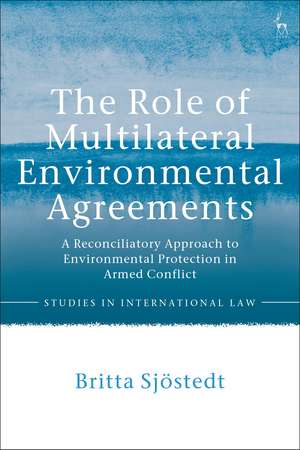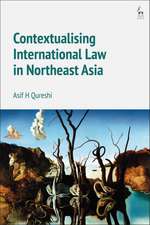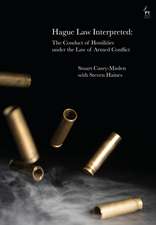The Role of Multilateral Environmental Agreements: A Reconciliatory Approach to Environmental Protection in Armed Conflict: Studies in International Law
Autor Britta Sjostedten Limba Engleză Hardback – 27 mai 2020
| Toate formatele și edițiile | Preț | Express |
|---|---|---|
| Paperback (1) | 300.42 lei 6-8 săpt. | |
| Bloomsbury Publishing – 24 noi 2021 | 300.42 lei 6-8 săpt. | |
| Hardback (1) | 571.34 lei 3-5 săpt. | |
| Bloomsbury Publishing – 27 mai 2020 | 571.34 lei 3-5 săpt. |
Din seria Studies in International Law
- 30%
 Preț: 598.45 lei
Preț: 598.45 lei - 30%
 Preț: 570.51 lei
Preț: 570.51 lei - 34%
 Preț: 512.30 lei
Preț: 512.30 lei - 34%
 Preț: 511.07 lei
Preț: 511.07 lei - 21%
 Preț: 275.26 lei
Preț: 275.26 lei - 18%
 Preț: 297.20 lei
Preț: 297.20 lei - 23%
 Preț: 249.26 lei
Preț: 249.26 lei - 30%
 Preț: 571.24 lei
Preț: 571.24 lei - 34%
 Preț: 509.52 lei
Preț: 509.52 lei - 30%
 Preț: 573.05 lei
Preț: 573.05 lei - 30%
 Preț: 538.77 lei
Preț: 538.77 lei -
 Preț: 448.39 lei
Preț: 448.39 lei - 30%
 Preț: 1138.79 lei
Preț: 1138.79 lei - 28%
 Preț: 406.31 lei
Preț: 406.31 lei - 21%
 Preț: 270.97 lei
Preț: 270.97 lei - 30%
 Preț: 570.43 lei
Preț: 570.43 lei - 30%
 Preț: 836.82 lei
Preț: 836.82 lei - 14%
 Preț: 570.43 lei
Preț: 570.43 lei - 30%
 Preț: 512.37 lei
Preț: 512.37 lei - 30%
 Preț: 511.14 lei
Preț: 511.14 lei - 30%
 Preț: 954.11 lei
Preț: 954.11 lei - 30%
 Preț: 572.47 lei
Preț: 572.47 lei - 30%
 Preț: 603.73 lei
Preț: 603.73 lei - 30%
 Preț: 779.50 lei
Preț: 779.50 lei - 14%
 Preț: 837.54 lei
Preț: 837.54 lei - 30%
 Preț: 898.78 lei
Preț: 898.78 lei - 30%
 Preț: 576.40 lei
Preț: 576.40 lei - 30%
 Preț: 719.91 lei
Preț: 719.91 lei - 30%
 Preț: 599.66 lei
Preț: 599.66 lei - 12%
 Preț: 233.46 lei
Preț: 233.46 lei - 30%
 Preț: 779.50 lei
Preț: 779.50 lei - 30%
 Preț: 570.43 lei
Preț: 570.43 lei - 14%
 Preț: 779.09 lei
Preț: 779.09 lei - 30%
 Preț: 540.38 lei
Preț: 540.38 lei - 30%
 Preț: 573.86 lei
Preț: 573.86 lei - 30%
 Preț: 542.02 lei
Preț: 542.02 lei - 28%
 Preț: 500.25 lei
Preț: 500.25 lei - 14%
 Preț: 574.92 lei
Preț: 574.92 lei - 30%
 Preț: 540.48 lei
Preț: 540.48 lei - 30%
 Preț: 778.12 lei
Preț: 778.12 lei - 30%
 Preț: 570.43 lei
Preț: 570.43 lei - 30%
 Preț: 515.24 lei
Preț: 515.24 lei - 30%
 Preț: 573.70 lei
Preț: 573.70 lei - 30%
 Preț: 720.23 lei
Preț: 720.23 lei - 30%
 Preț: 784.00 lei
Preț: 784.00 lei - 22%
 Preț: 571.24 lei
Preț: 571.24 lei - 14%
 Preț: 779.09 lei
Preț: 779.09 lei
Preț: 571.34 lei
Preț vechi: 817.44 lei
-30% Nou
Puncte Express: 857
Preț estimativ în valută:
109.36€ • 118.83$ • 91.92£
109.36€ • 118.83$ • 91.92£
Carte disponibilă
Livrare economică 31 martie-14 aprilie
Preluare comenzi: 021 569.72.76
Specificații
ISBN-13: 9781509922536
ISBN-10: 1509922539
Pagini: 336
Dimensiuni: 156 x 234 mm
Greutate: 0.64 kg
Editura: Bloomsbury Publishing
Colecția Hart Publishing
Seria Studies in International Law
Locul publicării:London, United Kingdom
ISBN-10: 1509922539
Pagini: 336
Dimensiuni: 156 x 234 mm
Greutate: 0.64 kg
Editura: Bloomsbury Publishing
Colecția Hart Publishing
Seria Studies in International Law
Locul publicării:London, United Kingdom
Caracteristici
First study looking at how international environmental law can apply in times of conflict
Notă biografică
Britta Sjöstedt is Senior Lecturer in Environmental Law at the Faculty of Law at Lund University, Sweden.
Cuprins
1. Setting the Scene I. Introduction II. Scope of the Book III. Why Read this Book? 2. Wartime Environmental Damage I. Introduction II. Categories of Wartime Environmental Damage III. Why Protect the Environment in Relation to Armed Conflict? 3. Special Protection under the Law of Armed Conflict I. Introduction II. The Foundations of the Law of Armed Conflict III. Adopting Special Environmental Protection in Warfare IV. Prohibition on Environmental Modification Techniques: The ENMOD Convention V. Absolute Environmental Protection in Protocol I VI. Conclusions4. Special Environmental Protection under Customary International Law I. Introduction II. ICRC Customary Law Study and the Draft Principles of the International Law Commission III. Special Environmental Protection in Non-international Armed Conflicts IV. Conclusions5. General Protection under the Law of Armed Conflict I. Introduction II. Applying the General Rules of Protection to the Environment III. Turning the Environment into a Military Target IV. Understanding the Attacker V. Proportionality TestVI. Calculating the Unknown: The Principle of Precaution versus the Precautionary Approach VII. 'Greening' the Martens Clause VIII. Other Rules of Importance IX. Protection under the Weapons Conventions X. Conclusions6. International Environmental Treaties: A Missed Opportunity I. Introduction II. International Environmental Law at a GlanceIII. Explaining the Missed Opportunity IV. Applicability of MEAs During Armed Conflicts V. The Lex Specialis Rule During Armed Conflicts VI. Meaningless MEAs? VII. Conclusions7. New Approach: Reconciling International Environmental Law and the Law of Armed Conflict I. Introduction II. The World Heritage Convention and the Ramsar Convention III. Potential Normative Tensions IV. Adopting a Reconciliatory Approach V. The Elements that Enable MEAs to Reconcile VI. Reconciliation: Is it Possible? VII. Role of Treaty Institutions VIII. Conclusions8. Protection of World Heritage in Relation to Armed Conflict: The Case of the DRC I. Introduction II. The Armed Conflicts III. The Impact of Armed Conflicts on World Heritage Sites IV. The Application of the World Heritage ConventionV. Contribution of the World Heritage Convention VI. Conclusions9. Protection of the Ramsar Sites in Relation to Armed Conflict: The Case of Mali I. Introduction II. The Armed Conflict III. Environmental Impacts and Rising Tensions in the Ramsar Sites IV. Application of the Ramsar Convention V. Contribution of the Ramsar Convention VI. Conclusions10. The Way Forward I. Introduction II. Shortcomings of the Law of Armed Conflict III. Exploring Other Options IV. New Outlook: From Lex Specialis to Reconciliation V. Factors Contributing to the Operation of MEAs in Relation to Armed ConflictVI. The Way Forward













